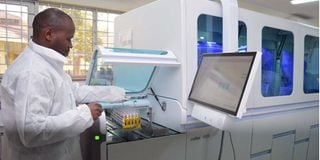Get funds to step up Aids fight effort

A laboratory technologist operates the Roche Cobas 880 Technology machine at Centre for Global Health Research in Kisian, Kisumu on July 12, 2018. The state-of-the-art molecular testing machine has had immense contribution in fight against HIV/AIDS and Malaria.
What you need to know:
- It is vital to bring on board anyone who is part of the problem, including people living with HIV and the higher-risk cluster, in the solution-seeking process.
- People living with HIV have been resourceful as activists and advocates for the Aids war, pushing for desperately needed resources and raising awareness.
Recently, Kenya Red Cross Society (KRCS) was picked to administer Sh27.47 billion from the Global Fund towards fighting the HIV/Aids epidemic in 2021-2024 as part of Kenya’s mission to halt new infections by 2030.
This demonstrates that a substantial war chest is of utmost importance in the war against this complex long-term epidemic.
More that 1.5 million Kenyans are estimated to be afflicted by the virus discovered in the 1980s by a team of French researchers. While it has no cure, the advent of antiretroviral drugs (ARVs), the side-effects notwithstanding, has been a resounding breakthrough in HIV-Aids research and, consequently, in the lives of people living with HIV.
The medication prolongs their lives, enabling them to lead a more or less quality life.
As for any epidemic, the yardstick of success in the fight against HIV is solely the lives saved through prevention. A lot has to be done to change its long-term trajectory.
It is vital to bring on board anyone who is part of the problem, including people living with HIV and the higher-risk cluster, in the solution-seeking process.
Raising awareness
People living with HIV have been resourceful as activists and advocates for the Aids war, pushing for desperately needed resources and raising awareness.
Impressively, there is recognition to include these people in public health boardrooms for policy formulation and also at grassroots to implement initiatives and interventions for people living with HIV. This should, however, be strengthened in practice.
With Aids a long-term epidemic, it is crucial to keep establishing solid epidemiological data guided by science and thorough surveillance as a baseline to measure progress.
A social and economic challenge and one that requires political heavy lifting for mobilisation of resources, Aids will have an impact on future generations. How it plays out as the population burgeons depends on today’s response and investment.





